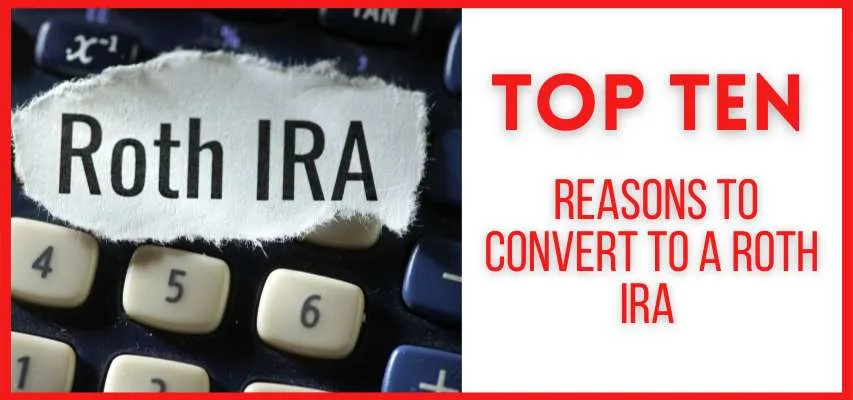A Roth IRA is a powerful retirement savings tool that offers tax-free withdrawals in exchange for contributing after-tax dollars. Unlike traditional IRAs with tax-deductible contributions but taxable withdrawals, a Roth IRA allows your investments to grow completely tax-free over time. While there are income limits for direct contributions, anyone can Convert to a Roth IRA, paying taxes on the converted amount to unlock the potential for tax-free retirement income. For maximum benefit, it’s crucial to pay these conversion taxes with cash, preserving the Roth IRA’s tax-advantaged status. Whether you’re a seasoned investor or just beginning your journey toward financial security, these reasons will showcase why a Roth IRA deserves a prime spot in your retirement planning strategy.
Also read: Top 10 Best Roth IRA Investments
Top 10 Reasons to Convert to a Roth IRA
A Roth IRA offers a distinctive set of advantages that can reshape your financial trajectory, both in the present and for your post-work years. In this comprehensive guide, we will delve into the benefits of converting to a Roth IRA, providing you with expert insights, real-world examples, and answers to frequently asked questions. When it comes to securing your financial future and making informed decisions about your retirement planning, considering the Top 10 Reasons to Convert to a Roth IRA is a strategic move that can have a significant impact on your financial well-being.

1. Tax-Free Withdrawals in Retirement
When you contribute to a Roth IRA, your future withdrawals are tax-free, provided you adhere to the withdrawal rules. This tax advantage is a game-changer, as it ensures that the money you withdraw during your retirement years won’t be subject to taxes, allowing you to enjoy your retirement savings to the fullest.
Example: Let’s say you have contributed consistently to your Roth IRA over the years. When you retire and start withdrawing funds, you won’t have to worry about paying taxes on those withdrawals, enabling you to maintain your desired lifestyle without the burden of taxes.
Also, read: Top 10 High-Yield Savings Accounts in the USA
2. Diversify Your Retirement Portfolio
Diversification is key to a successful retirement strategy. Converting to a Roth IRA gives you the opportunity to diversify your investment portfolio further. By having a mix of both pre-tax and post-tax retirement accounts, you can better manage your tax liability and create a balanced financial future.
Example: You can allocate a portion of your investments to a Roth IRA, including high-growth assets like stocks. This diversification can lead to potential higher returns while also ensuring that you have tax-free income during retirement.
3. No Age Limit for Contributions
Unlike traditional IRAs, Roth IRAs don’t have age limits for contributions. This means that even if you continue working past the typical retirement age, you can keep contributing to your Roth IRA, allowing your savings to grow even further.
Example: If you’re passionate about your career and plan to work beyond the age of 70, a Roth IRA provides an avenue to keep saving and benefiting from tax-free withdrawals down the road.
Also, read: Top 10 Low-Cost Investment Platforms for US Beginners in 2024
4. Flexibility in Withdrawals
While it’s generally recommended to keep your funds in a Roth IRA for as long as possible to maximize growth, life can bring unexpected financial needs. With a Roth IRA, you can withdraw your contributions (not earnings) at any time without penalties or taxes, offering you a safety net in times of urgency.
Example: Imagine facing a sudden medical expense or home repair. Your Roth IRA contributions can act as a financial cushion, providing you with the flexibility to cover these expenses without penalties.
5. Estate Planning Benefits
A Roth IRA can be an excellent tool for estate planning. Since there are no required minimum distributions (RMDs) during your lifetime, you can leave your Roth IRA to your heirs, who can then enjoy tax-free distributions over their lifetime. This creates a legacy of financial security for your loved ones.
Example: Suppose you want to leave a lasting financial legacy for your children or grandchildren. By passing on a Roth IRA, you’re providing them with a source of tax-free income that can significantly contribute to their financial stability.
Also, read: Top 10 Biggest Banks by Market Cap in the World 2024
6. Potential for Higher Returns
The Roth IRA’s long-term growth potential can be substantial. With the ability to invest in a wide range of assets, including stocks, bonds, and mutual funds, your Roth IRA has the potential to generate higher returns compared to traditional savings accounts.
Example: Investing in a diversified portfolio within your Roth IRA can lead to substantial growth over time. For instance, historically, the stock market has shown higher returns compared to traditional savings methods.
7. No Mandatory Withdrawals
Unlike traditional IRAs that require you to start taking RMDs at age 72, Roth IRAs have no mandatory withdrawal age. This gives you greater control over your retirement income and allows your investments to potentially grow for a longer period of time.
Example: Let’s say you’re in excellent financial shape during your retirement years and don’t need to tap into your Roth IRA immediately. With no required withdrawals, you can let your investments continue growing tax-free until you’re ready to use them.
Also, read: Top 10 Ways to Save Money on Everyday Expenses in 2024
8. Lock in Tax Rates
With potential changes in tax laws in the future, converting to a Roth IRA now allows you to lock in your current tax rates. This can be especially advantageous if you believe that tax rates may increase in the years to come.
Example: If you anticipate that taxes might rise in the future, converting to a Roth IRA lets you pay taxes at your current rate. This can result in significant savings over time, as you won’t be affected by potential tax rate hikes.
9. Hedge Against Future Taxes
In an unpredictable economic landscape, having tax diversification is crucial. A Roth IRA serves as a hedge against future tax changes. By having tax-free withdrawals, you won’t be affected by potential tax rate increases.
Example: Economic conditions can change, affecting tax rates. By having a Roth IRA, you’re safeguarding your retirement income from the impact of fluctuating tax rates, giving you peace of mind.
Also, read: Top 10 Tips for Choosing the Right Car Insurance in the USA in 2024
10. Financial Freedom in Retirement
Ultimately, converting to a Roth IRA grants you a higher degree of financial freedom during your retirement years. The tax benefits, flexibility, and growth potential combine to provide you with a secure foundation for your post-work life.
Example: With a well-funded Roth IRA, you have the freedom to pursue your passions, travel, or indulge in hobbies during retirement without constantly worrying about finances.
FAQs: Reasons to Convert to a Roth IRA
Q: Can I convert my existing traditional IRA to a Roth IRA?
Yes, you can convert your traditional IRA to a Roth IRA. However, keep in mind that you’ll need to pay taxes on the amount you convert, as it’s treated as taxable income.
Also, read: Top 10 Financial Literacy Resources to Educate Yourself About Money Management
Q: What’s the income limit for Roth IRA conversions?
The income limits for Roth IRA conversions in 2023 are as follows:
- Single filers: The phase-out range is $138,000 to $152,999.
- Married filing jointly: The phase-out range is $218,000 to $227,999.
- Married filing separately: There is no income limit for conversions if you file separately. However, you cannot convert any amount of your traditional IRA if your modified adjusted gross income (MAGI) is more than $109,000.
If your income is above the phase-out range, you can still convert your traditional IRA to a Roth IRA, but you will have to pay taxes on the amount that you convert. The amount that you have to pay taxes on is the fair market value of your traditional IRA on the day of the conversion.
Here is an example:
- Let’s say you are single and your MAGI is $140,000 in 2023.
- You have a traditional IRA with a balance of $100,000.
- If you convert your traditional IRA to a Roth IRA, you will have to pay taxes on $2,000. This is the difference between your MAGI of $140,000 and the phase-out limit for single filers of $138,000.
- The $2,000 that you have to pay taxes on will be added to your taxable income for the year.
- You will also have to pay a 10% early withdrawal penalty if you are under the age of 59 when you make the conversion.
It is important to note that the income limits for Roth IRA conversions are subject to change each year. You should always check with the IRS for the latest information before you convert your traditional IRA to a Roth IRA.
Also, read: Top 10 Financial Apps to Simplify Your Money Management in 2024
Q: Are Roth IRA contributions tax-deductible?
No, Roth IRA contributions are not tax-deductible. However, the advantage comes during retirement, when your withdrawals are tax-free.
Q: Is there a penalty for early withdrawals from a Roth IRA?
While you can withdraw your contributions penalty-free, withdrawing earnings before age 59½ might result in a 10% early withdrawal penalty.
Q: Can I have both a Roth IRA and a traditional IRA?
Yes, you can have both types of IRAs, but there are contribution limits that apply to the total amount you contribute to both accounts.
Also, read: Top 10 Investment Strategies for a Volatile Market in 2024
Q: How do I open a Roth IRA?
You can open a Roth IRA through various financial institutions, such as banks, brokerage firms, and online investment platforms. It’s a relatively straightforward process that typically involves filling out an application
Conclusion: The Final Words
The decision to convert to a Roth IRA is a strategic move that can significantly impact your financial future. By carefully considering the ten reasons outlined, you’ve gained valuable insights into the potential benefits of this conversion. Remember, every financial situation is unique. What works for one person may not be ideal for another. Consulting with a qualified financial advisor can help you determine if a Roth IRA conversion aligns with your specific goals and circumstances. Ultimately, the decision to convert is a personal one, but understanding the potential advantages can empower you to make informed choices that support your long-term financial well-being.
Also, read: Top 10 Emerging FinTech Trends Transforming Personal Finance in 2024


































